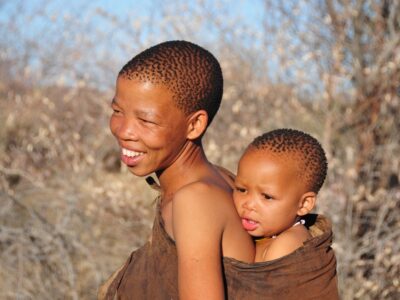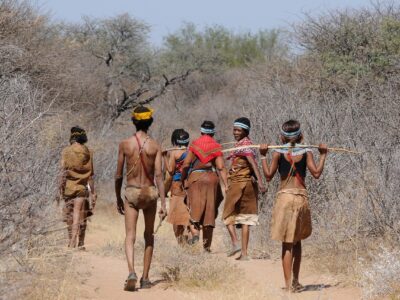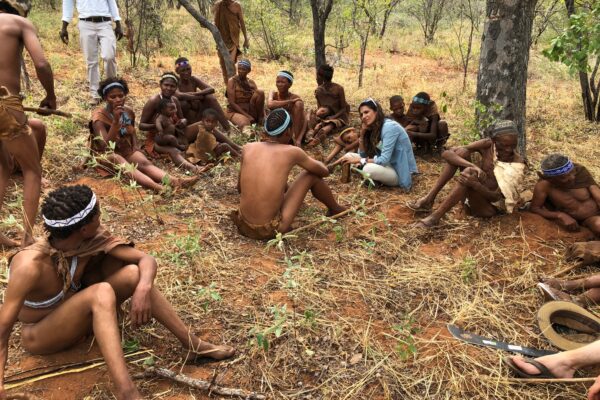The Khoisan People: Facts, History, Culture, And Language
The Khoisan People: All You Should Know
Explore the rich legacy of the Khoisan People: delve into ancient origins, cultural traditions, historical milestones, and unique click‑language heritage.
The Khoisan people are among Africa’s oldest and most culturally rich communities, renowned for their deep connection to the land and their unique hunter‑gatherer heritage. Spanning regions of southern Africa, including modern‑day Botswana, Namibia, Angola, Zambia, Zimbabwe, and South Africa, the Khoisan comprise two main groups: the “Khoi” pastoralists and the “San” hunter‑gatherers. Their traditional lifeways emphasize sustainable resource use, intricate tracking and foraging skills, and a profound spiritual relationship with the natural world. Distinctive click‑based languages, some of the world’s oldest linguistic systems, carry their ancestral stories, knowledge of medicinal plants, and social wisdom from one generation to the next.
Today, the Khoisan continue to inspire global interest in indigenous rights, cultural preservation, and biodiversity conservation. Community‑led initiatives showcase their rock‑art heritage in UNESCO‑recognized sites, while eco‑tourism ventures offer visitors authentic guided bush walks and storytelling sessions around the campfire. Despite historical marginalization, Khoisan artisans are revitalizing traditional crafts, beaded jewelry, leatherwork, and folklore art, bridging ancient traditions with contemporary markets. Supporting Khoisan cultural projects not only helps safeguard a millennia‑old legacy but also promotes sustainable livelihoods, ensuring these resilient peoples remain custodians of Africa’s oldest living heritage for generations to come.
The Khoisan People: All You Should Know
The Khoisan People Facts
The Khoisan are considered the oldest indigenous peoples of southern Africa, with genetic lineages tracing back over 100,000 years. Comprised primarily of two distinct groups—the San (hunter‑gatherers) and the Khoi (pastoralists)—their combined population today numbers in the tens of thousands, spread across Namibia, Botswana, South Africa, Angola, and parts of Zambia and Zimbabwe. Renowned for their remarkable tracking and foraging skills, the San traditionally subsist on wild game and edible plants, while the Khoi maintain small herds of sheep and cattle. Physically, many Khoisan individuals share lighter skin and unique facial features compared to neighboring Bantu and European populations. Their deep ecological knowledge has made them invaluable partners in modern conservation and ethno‑botanical research.
The Khoisan PeopleHistory
The Khoisan represent some of humanity’s earliest cultural innovators, with archaeological evidence—such as Blombos Cave engravings and Apollo 11 rock art—dating back tens of thousands of years. Long before the arrival of Bantu-speaking farmers around 2,000 years ago, Khoisan bands roamed widely across southern Africa’s savannahs, deserts, and shrublands. European colonization from the 17th century onward decimated their populations through disease, land dispossession, and conflict, relegating many to marginalized reserves. Despite these hardships, Khoisan communities demonstrated resilience by blending pastoralism, wage labor, and traditional practices. In the late 20th century, indigenous rights movements in South Africa and Namibia began to recognize Khoisan ancestral land claims, leading to landmark court rulings and government initiatives aimed at cultural restitution and heritage protection.
The Khoisan People Culture
Khoisan culture is deeply tied to the land, emphasizing harmony with nature, communal decision‑making, and ritual practices that honor animal spirits. The San are famed for their trance dances, in which song and rhythmic clapping invoke healing and communal bonding, while both groups create rock paintings and engravings that narrate hunting scenes, spiritual beliefs, and migration stories. Artisans produce intricate crafts—beaded jewelry, ostrich‑shell beads, and leatherwork—each symbolizing clan identity or spiritual motifs. Storytelling by elders transfers ecological wisdom and moral values, teaching younger generations about plant medicines, animal behaviors, and ethical conduct. Despite modern influences, many Khoisan people maintain seasonal camps, supplementing traditional subsistence with eco‑tourism guiding and cultural workshops to share their heritage.
The Khoisan People Language
Khoisan languages form one of the world’s most ancient and complex linguistic families, characterized by click consonants that can number up to twelve distinct sounds per language. Traditionally divided into three branches—Khoe, Tuu, and Kx’a—these tongues feature tonal patterns and elaborate grammatical structures uncommon elsewhere. Once spoken by hundreds of thousands, today fewer than 30,000 fluent speakers remain, as many communities shift to dominant national languages like Afrikaans or Setswana. Linguists value Khoisan languages for insights into human speech evolution and phonetic diversity, leading to preservation projects that train local teachers and develop written orthographies. Community radio programs, school curricula, and digital apps now strive to revitalize mother tongues, ensuring that click‑rich Khoisan voices endure for future generations.
Travel Advice From JimJam Safaris
We cater to all ages, budgets, interests, and fitness levels. Our team can assist with queries about the Khoisan tours, Accommodations, bookings, and Affordable Luxury destinations. We will respond to your Inquiry as soon as possible. Our team of friendly and service-minded Safari Consultants is available to assist you in making a private, personalized, tailor-made Safari Itinerary and to answer all questions you might have. Are you dreaming of the Wildebeest Migration? Gorilla Trekking in Africa? Honeymoon In Africa or Africa’s Big 5 Experiences? Start planning your affordable luxury African tours with the Affordable Luxury African Safari Company (JimJam Safaris & Tours Africa). We tailor-make African Safaris for First Timers, 7-Day African Safari Tours, African Bush Safaris, and Beach Vacations.


